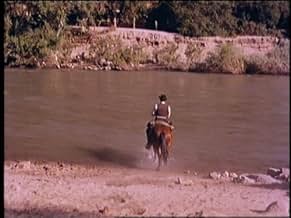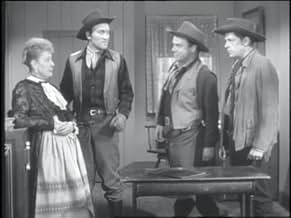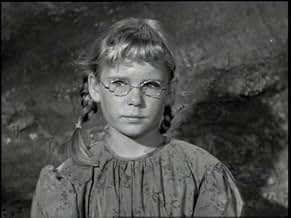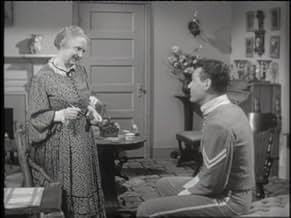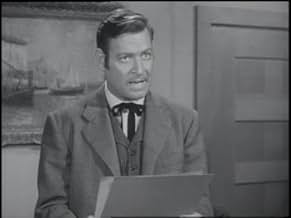Ajouter une intrigue dans votre langueThe adventures of the masked hero and his Native American partner.The adventures of the masked hero and his Native American partner.The adventures of the masked hero and his Native American partner.
- Nommé pour 2 Primetime Emmys
- 3 nominations au total
Parcourir les épisodes
Histoire
Le saviez-vous
- AnecdotesThe Lone Ranger's young nephew, Dan Reid, who appeared occasionally on this show, was the father of Britt Reid, The Green Hornet. Both characters were created for radio by George W. Trendle.
- GaffesIn the series opening used in syndication, the Lone Ranger is seen riding past rows of trees planted as wind breaks. This practice did not come into use until after the "dust bowl" windstorms of the 1930s.
- Citations
[first lines for each episode]
Narrator: The Lone Ranger!
[gunshots are fired]
The Lone Ranger: Hi-yo, Silver!
Narrator: A fiery horse with the speed of light, a cloud of dust and a hearty "Hi-yo Silver" - the Lone Ranger!
The Lone Ranger: Hi-yo, Silver, away!
Narrator: With his faithful Indian companion, Tonto, the daring and resourceful masked rider of the plains led the fight for law and order in the early West. Return with us now to those thrilling days of yesteryear. The Lone Ranger rides again!
- Versions alternativesThe first three episodes are available edited together as a ersatz feature "Enter the Lone Ranger" (1949) running 68 minutes minus titles and recaps.
- ConnexionsEdited into The Legend of the Lone Ranger (1952)
- Bandes originalesWilliam Tell Overture: Finale
by Gioachino Rossini
Commentaire à la une
Someone once defined what is the definition of AN INTELLECTUAL as being: "A person who can listen to "The William Tell Overture" without thinking of the LONE RANGER!" In this, we heartily concur! It surely would be a tall order to accomplish this, and one that Leopold Stokowski, Arturo Toscanini or .Leonard Bernstein would all find nigh well impossible to do.
And in this there is no disgrace. The Radio Series and the Television Series, along with some Movie Serials, Feature Films, Syndicated Newspaper Comic Strip and Comic Books, all did their part to make "the Masked Man of the Plains and his Faithful Indian companion, Tonto" a deeply seeded element of our collective psyche and of our literary folklore.
As with most legends, it all started gradually, first with a series of Radio Plays, written for local use in Detroit over Radio Station WXYZ. The Creator was one George W. Trendle and the Principal Writer on the Series was Mr. Trendle's brother-in-law, Mr. Fran Striker. The year was 1933 when the Ranger first rode out to " the Plains of the Early Western United States!" The Lone Ranger, Tonto and the Radio Series all successfully guided Depression Era Americans through the mid and late '30's up to and through World War II. But the Post-War Era found the country in the midst of a Super-Nova Explosion of invention and technology. There had been a new communications medium standing ready in the wings, but unable to go forth until both VE Day and VJ Day had been achieved. Once these were accomplished and the World and America was ready to settle down to both Peace and Prosperity. The "New Technology" was, of course was TELEVISION! And we would surely need something else than "Roller Derby" and "Wrestling From Marigold Arena" to fill up the broadcast hours. And while at first, the time that a TV Station had anything on, except that portrait of that Mohican Chief (Test Pattern, Schultz!) Very soon and with post haste, the Networks began tapping their existing Natural Resources, their existing programming! Virtually all would be ripe for adaptation to the TV Screen.
So, the folks over at Lone Ranger, Incorporated were very interested when Producers Jack Chertok, Harry Poppe, Sherman Harris and Jack Wrather all approached them with a deal to put The Masked Man and Tonto on the Television waves, as well as the Radio.
Immediately they went to work and gave us the first season, which made use of the considerable back log of Radio Dramas, all potentially adaptable to TV dramas. They cast Clayton Moore, a fine supporting actor in many a feature film, and with about a dozen years experience. He also had done some work in Serials over at Republic Pictures' "Thrill Factory", which would be invaluable experience in doing "THE LONE RANGER". Cast as his "faithful Indian companion" and partner in bringing Justice to various parts of the Frontier, we had sheer perfection in character-supporting Actor, Jay Silverheels.** We must mention that there was that rift in about '53, when Clayton Moore walked and was replaced with John Hart. After a season or so, Mr. Moore was back in-having been missed so much! Now, Back to Our Story!! The first years of filming gave the episodes a look and a sound all of their own. They made good use of off screen Narrator, which gave these shows a feel of authenticity and an individual, stand-out one of a kind series. The actors employed were all veterans of the movies of the late silent era thru the 1930's and 1940's. A lot of them had been just about exclusively "Cowboy Movie" players. A good example of these is the casting of Glenn Strange (Bartender Sam on "GUNSMOKE") as the vicious, murderous Gang Leader, Butch Cavandish. And it was the Cavendish Gang's massacre of the Texas Rangers that led to the origin of John Reid (thought to have been slain with the other Texas Rangers) as the "LONE RANGER".
In addition to the old timers in the cast, you will find a lot of new and up and coming talent (then) in the cast. We see people like Phyllis Coates, Dwayne Hickman, Denver Pyle and others in the cast from week to week. All of this, along with an always calling for fair-play, justice and peace in a western world.
The last couple of seasons brought some big changes. First was the use of Colour Filming. That made no difference as a Colour TV Set was still a long way off for our household. The second was a new set of musical themes and queues. (Other than Rossini's Finale from "U NO Wutt!") The new music was never a big deal to us, as we preferred the "old Radio" stock stuff.
With this series and two Feature Films done during this period, THE LONE RANGER (Warner Brothers, 1956) and THE LONE RANGER AND THE LOST CITY OF GOLD (United Artists, 1958), the character has been permanently and indelibly impressed in our identity as a People, we Americans!
And in this there is no disgrace. The Radio Series and the Television Series, along with some Movie Serials, Feature Films, Syndicated Newspaper Comic Strip and Comic Books, all did their part to make "the Masked Man of the Plains and his Faithful Indian companion, Tonto" a deeply seeded element of our collective psyche and of our literary folklore.
As with most legends, it all started gradually, first with a series of Radio Plays, written for local use in Detroit over Radio Station WXYZ. The Creator was one George W. Trendle and the Principal Writer on the Series was Mr. Trendle's brother-in-law, Mr. Fran Striker. The year was 1933 when the Ranger first rode out to " the Plains of the Early Western United States!" The Lone Ranger, Tonto and the Radio Series all successfully guided Depression Era Americans through the mid and late '30's up to and through World War II. But the Post-War Era found the country in the midst of a Super-Nova Explosion of invention and technology. There had been a new communications medium standing ready in the wings, but unable to go forth until both VE Day and VJ Day had been achieved. Once these were accomplished and the World and America was ready to settle down to both Peace and Prosperity. The "New Technology" was, of course was TELEVISION! And we would surely need something else than "Roller Derby" and "Wrestling From Marigold Arena" to fill up the broadcast hours. And while at first, the time that a TV Station had anything on, except that portrait of that Mohican Chief (Test Pattern, Schultz!) Very soon and with post haste, the Networks began tapping their existing Natural Resources, their existing programming! Virtually all would be ripe for adaptation to the TV Screen.
So, the folks over at Lone Ranger, Incorporated were very interested when Producers Jack Chertok, Harry Poppe, Sherman Harris and Jack Wrather all approached them with a deal to put The Masked Man and Tonto on the Television waves, as well as the Radio.
Immediately they went to work and gave us the first season, which made use of the considerable back log of Radio Dramas, all potentially adaptable to TV dramas. They cast Clayton Moore, a fine supporting actor in many a feature film, and with about a dozen years experience. He also had done some work in Serials over at Republic Pictures' "Thrill Factory", which would be invaluable experience in doing "THE LONE RANGER". Cast as his "faithful Indian companion" and partner in bringing Justice to various parts of the Frontier, we had sheer perfection in character-supporting Actor, Jay Silverheels.** We must mention that there was that rift in about '53, when Clayton Moore walked and was replaced with John Hart. After a season or so, Mr. Moore was back in-having been missed so much! Now, Back to Our Story!! The first years of filming gave the episodes a look and a sound all of their own. They made good use of off screen Narrator, which gave these shows a feel of authenticity and an individual, stand-out one of a kind series. The actors employed were all veterans of the movies of the late silent era thru the 1930's and 1940's. A lot of them had been just about exclusively "Cowboy Movie" players. A good example of these is the casting of Glenn Strange (Bartender Sam on "GUNSMOKE") as the vicious, murderous Gang Leader, Butch Cavandish. And it was the Cavendish Gang's massacre of the Texas Rangers that led to the origin of John Reid (thought to have been slain with the other Texas Rangers) as the "LONE RANGER".
In addition to the old timers in the cast, you will find a lot of new and up and coming talent (then) in the cast. We see people like Phyllis Coates, Dwayne Hickman, Denver Pyle and others in the cast from week to week. All of this, along with an always calling for fair-play, justice and peace in a western world.
The last couple of seasons brought some big changes. First was the use of Colour Filming. That made no difference as a Colour TV Set was still a long way off for our household. The second was a new set of musical themes and queues. (Other than Rossini's Finale from "U NO Wutt!") The new music was never a big deal to us, as we preferred the "old Radio" stock stuff.
With this series and two Feature Films done during this period, THE LONE RANGER (Warner Brothers, 1956) and THE LONE RANGER AND THE LOST CITY OF GOLD (United Artists, 1958), the character has been permanently and indelibly impressed in our identity as a People, we Americans!
Meilleurs choix
Connectez-vous pour évaluer et suivre la liste de favoris afin de recevoir des recommandations personnalisées
- How many seasons does The Lone Ranger have?Alimenté par Alexa
Détails
- Date de sortie
- Pays d’origine
- Langue
- Aussi connu sous le nom de
- El llanero solitario
- Lieux de tournage
- Sociétés de production
- Voir plus de crédits d'entreprise sur IMDbPro
- Durée30 minutes
- Rapport de forme
- 1.33 : 1
Contribuer à cette page
Suggérer une modification ou ajouter du contenu manquant

Lacune principale
By what name was The Lone Ranger (1949) officially released in India in English?
Répondre


